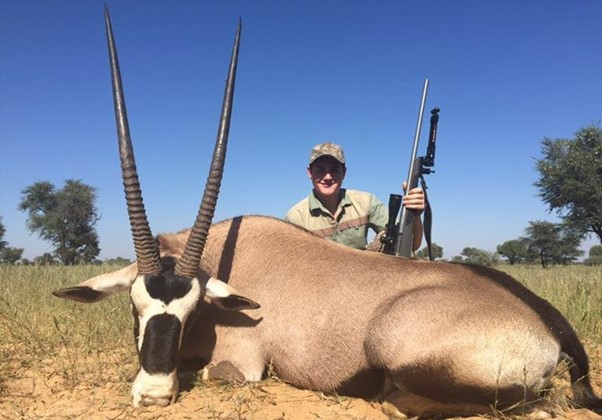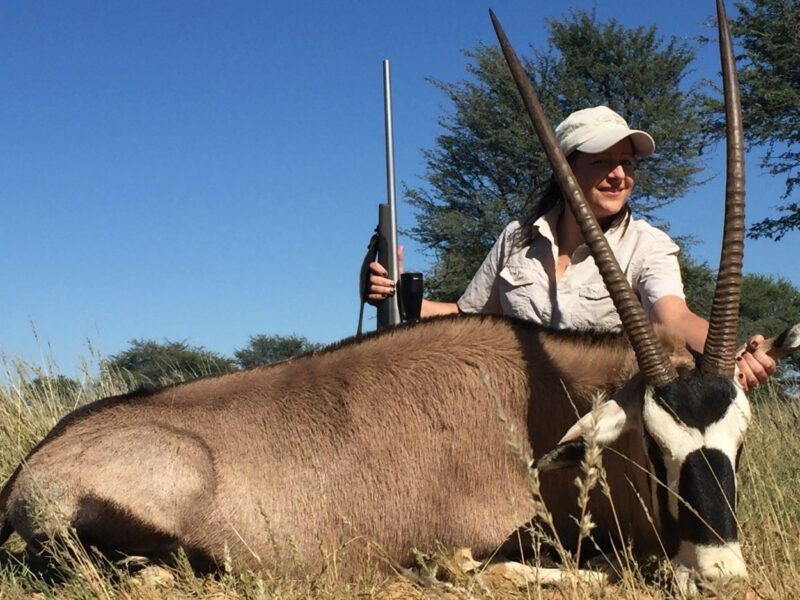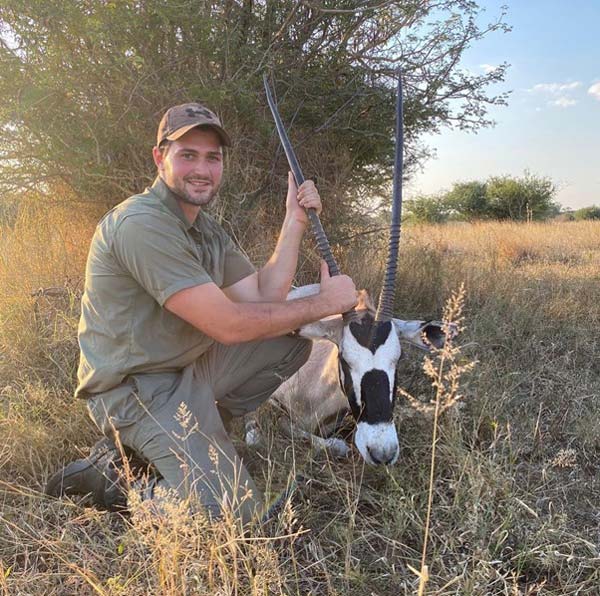When it comes to an African plains game hunting safari, taking on the iconic Gemsbok (Oryx Gazella) is not such an easy task.
[DYNAMIC-BLOGTABLEOFCONTENT]
Let’s Kick off and Address some of the FAQS
Where is the best place to hunt Gemsbok?
Gemsbok hunting safaris are best in the Kalahari Desert.
Which Rifle is Best for Gemsbok Hunting?
The best rifle for gemsbok hunting would be a 30.06 caliber Springfield or a 300 Winchester Magnum. On an antelope, this tough, a .375 loaded with solid/monolithic bullets can also work exceptionally well.
Where do you shoot a Gemsbok?
- Gemsbok are very tough antelope and the correct Gemsbok shot placement is critical. The hunter would ignore the brain/headshot as shooting distances can easily be over 350 yards. A headshot will also ruin the trophy.
- With the gemsbok having such a thick neck, the spinal shot is to be avoided.
- The best placement to shoot a gemsbok would be when the antelope is standing broadside. A well-placed shot, a third of the way up the front shoulder will penetrate the heart and a near miss will result in a fatal double lung shot.
- Warning: Gemsbok shot placement when broadside. The gemsbok has a hump on the top of its shoulder. The hunter needs to ignore this when measuring the 1/3 of the way up the front shoulder. A bullet placed too high will result in the vital organs being missed.
- Find out more about shot placement on large antelopes.
In which countries can you enjoy Gemsbok hunting?
Gemsbok hunting is conducted in the African arid and semi-arid bushlands of Namibia, South Africa, Botswana, and a few areas within Zimbabwe.
Can Gemsbok Meat be eaten?
Gemsbok meat is a favorite and probably one of the biggest delicacies on the African continent and is rated far superior to deer, such as elk, in the USA. The meat from a gemsbok hunting safari cannot be exported to the USA, Australia, or Europe. Your chef will be sure to grill some gemsbok backstraps on the open flame.
A Brief Description of the Gemsbok Antelope
This infamous antelope derives its name from the Dutch and Afrikaans dialect. Gemsbok are tan in color with the fur coloring being slightly lighter near the rump of the antelope.
A famous coloring is the long black stripe extending from the chin, through the neck, and ending at the rear leg, just above the white socks.
Gemsbok have powerful shoulders, necks, and legs allowing these antelope to easily ascend the Kalahari Desert’s famous sand dunes.
Noticeably, both the male and female gemsbok have long and straight horns. The female gemsbok’s horns can often be longer and thinner than the males and the desire for a female trophy often outweighs that for a male gemsbok trophy. The gemsbok is, in fact, the largest antelope in the genus Oryx.

The above image shows my son Keenan and a great gemsbok trophy taken in the Kalahari. Note the flat terrain as well as the sharpness of the horns. Due to the thick bases of the horns, the gemsbok can clearly be distinguished as a male.
During the cold winter months, these summer grasses in fact “die off” and the hunter will walk and battle through thick sand.
An interesting fact when Gemsbok hunting in the Kalahari As the Kalahari Desert is mostly sand, the gemsbok’s hooves, just like human nails, continue growing. It makes tracking the gemsbok quite challenging for the hunter as the tracks are not recognizable in the traditional sense. Tracking a gemsbok in the Kalahari is best left to the Bushman, who are master trackers and have been specializing in this art for thousands of years.
Biology and Ecology of the Gemsbok
The graceful antelope lives in small herds of between 10 to 50 antelope under the watchful eye of a dominant male. Gemsbok, being accustomed to the desert conditions, are not water dependent for their physiological needs.
They are fast and can reach a running speed of over 35 miles per hour and can travel great distances.
Gemsbok are primarily grazers, but during the drier winter months also browse on leaves and any available low-hanging fruits. These antelopes are also known to dig up roots and tubers and enjoy feeding on melons to supplement their water needs.
My wife Tamlyn hunted the below gemsbok, also in the Kalahari region of Southern Africa. It took more than two days of walking to successfully track and harvest this beautiful gemsbok bull. Tamlyn made use of her trusty 300 Winchester Magnum, loaded with 180-grain Hornady ELDX high-quality expanding bullets. Kill shots can be at great distances, so a rifle shooting a flat trajectory is recommended when gemsbok hunting.
A useful tip when photographing your trophy gemsbok: As the horns are spectacular, when taking the picture always ensure that the horns have the blue sky of the Kalahari as the backdrop, not the shrubs and trees, as these images will negatively affect the quality of the photograph.

Gemsbok Reproduction: Facts and Stats
- A Gemsbok antelope is polygynous.
- What is the meaning of polygynous? Polygynous means that one resident and dominant male will mate with receptive females in the same herd of antelope.
- Gemsbok have no specific breeding season, but young gemsbok offspring tend to be of a similar age. This could largely be due to the reproductive synchrony of the female gemsbok.
- Female gemsbok have a gestation period that averages 270 days (similar to Sable) and they are capable of producing twins. The mother will try to hide the calf for approximately six weeks. Weaning will take place at approximately 3 and ½ months and the calf will be sexually mature from 18 months to two years, in both males and females.
- A gemsbok hunting safari is worth the effort, just to catch a glimpse of a newly-born calf. They are absolutely adorable in every way!
A Gemsbok’s Close Relatives
The Gemsbok, also known in English as the Gemsbuck, or Giant Oryx, is closely related to the Beisa (also known as the East African Oryx) and the Fringe-Eared Oryx.
Both of these relatives can be hunted in Tanzania and further North in Tanzania.
The gemsbok hunt below was done by my friend Mynhardt, who hunted this bull in the Kalahari, South Africa. Unfortunately, the shot placement on this gemsbuck was poor. The result was that Mynhardt and his band of tackers spent two full days walking through the desert trying to follow tracks and look for blood splatter.
Without success, eventually, horses were brought in and on the third morning, the gemsbok was found. Again, we reiterate, that gemsbok shot placement is critical. Rather do not take a chance on potentially missing the target, as there are plenty of trophy gemsbok in South Africa.
Due to the time frame and the fact that the gemsbok was filled with adrenaline, the meat was not that great. Mynhardt used a Tikka 30.06 for the gemsbok hunting safari. When it comes to gemsbok hunting, and perhaps because I am not the best marksman at such long distances, I prefer a rifle with more “punch.” I use a Mauser 300 Win-Mag. As much as I love the Kalahari Desert, spending all my time on an African plains game hunting safari looking for wounded animals is not my idea of fun. But, as hunters and conservationists, it does happen, and we deal with consequences accordingly.

A Gemsbok Hunt in Africa
What does it Cost to Hunt a Trophy Gemsbok?
When pondering a gemsbok hunt in Africa, the day rates will be the bigger cost of the hunting safari. Gemsbok hunting is usually done in conjunction with other African plains game such as springbuck, black wildebeest, or exotic antelope such as sable and roan. The daily rates, depending on the location and duration of the hunting safari, can vary between US $ 250 and US $500 per day per hunter.
The trophy fee per African region is as follows:
- South Africa: US $ 1,500 to US $ 1,750
- Namibia: US $800 to US $ 1,200
- Zimbabwe: US 1,750 to US $1,850
- Botswana: US $1,500 to US $1,750
What size Gemsbok is considered a Trophy Specimen?
A decent-sized gemsbok bull needs to have a horn measurement of between 36 and 38 inches. A gemsbok bull measuring over 40 inches is classified as meeting the Rowald Ward minimum. Safari Club International’s minimum trophy size is 81.
As males gemsbok often spend their time fighting, their horns are often snapped at the tips, or ground a little shorter. As the bases are not factored into working the trophy measurements, females, who do not engage in regular battle, often have longer horns.
In other areas, depending on genetics, gemsbok bulls tend to get larger in the body, weighing more, with shorter horns. The current world-class record length for a gemsbok bull is 49 and 4/8 inches.
Hints when judging Gemsbok Horn Size
It is exceptionally difficult to judge a lone gemsbok bull from a distance. The reality is, that a young and juvenile bull is in the same proportion as an adult bull. On many occasions, I have witnessed young bulls being shot by the hunter making the judgement decision in terms of horn size. Gemsbok are not as easy to judge when compared to a kudu bull, where the number of curls can be assessed and counted.
Take advice from the professional hunter, as they judge gemsbok trophy bulls regularly.
My friend, Dawie, shot the below gemsbok in the Northern Cape, South Africa. You can notice the thick grass after good summer rains. Points to consider and take note of:
- Dawie made use of a 30.06 loaded with Peregrine 180 bullets. Also, the rifle has been fitted with a suppressor. Many ranch owners in Africa prefer hunters to use suppressors, but it is not compulsory.
- The below Gemsbok was big in body but notice the shorter length of the horns.

When is the Best Season to Hunt Gemsbok in Africa?
Gemsbok hunting in African countries can be hunted all year round as there are no restrictions in terms of a regulated hunting season. African summers are known for the heat and rain, which bring along unpleasant critters such as ticks, and spiders, and, of course, the risk of sunstroke which is a very real possibility.
Temperatures during the winter months drop extensively at night, however, the daytime temperatures are far warmer making for a far more pleasant hunting safari.
Bow Hunting the Gemsbok
Gemsbok may be hunting using a bow, however, always check the country’s minimum legal requirements.
As we know, gemsbok are not water-dependent antelope, and setting up a blind near a water source is not necessarily going to result in success. As such, there will not necessarily be a pattern in terms of drinking, which is going to mean a successful gemsbok hunt with a bow is going to require a great deal of patience.
In large concession areas, African outfitters will construct blinds, and bait by making use of salt, or game blocks, rich in minerals to entice the illusive emsbok. When in the blind in large expanses of land, remember that Ggemsbok can, and will, approach the blind from any angle. These antelope are silent and highly alert, so be patient and limit movement, else the only movement seen will be the gemsbok bolting into the distance.
How to Successfully Hunt Gemsbok
There are a few different methods that can be considered when gemsbok hunting, but the reality is that these methods vary, considering the topography, size, and habitat of the concession or privately owned ranch.
Bushveld Gemsbok Hunting
When hunting gemsbok in these large woodland areas, generally make use of a four-by-four vehicle to either find fresh tracks or hope to spot the trophy gemsbok. Tracking in the sand is exceptionally difficult, so it is preferable to get a visual on a potential trophy gemsbok.
Hunters will then strategize and plan how best to approach the antelope, determine wind direction, and seek the cover of the tree lines. Early morning glassing can be done, but the reality is that the hunting areas are massive in size and chances are not always good. Glassing for gemsbok is not the same as glassing for a kudu bull on high mountain ridges. They are always on alert and will be sure to bolt at the first sign of a disturbance or threat.
Dune Gemsbok hunting in the Desert
Walking down a gemsbok over the open desert dunes is not such a simple task. Hunters have to be super fit and have a bag full of luck in their possession! With the desert being mostly sand and tufts of brush, the carrying capacity per square mile is very low. As such hunters will need to cover endless miles, which will take a really long time.
Lightweight vehicles are made use of, and they are customized to deal with the vast amount of sand in an attempt for the hunting party to cover as much ground as possible.
The vehicle will then traverse up the crest of every dune and once a mature trophy gemsbok has been sighted, the hunters will then go back down and out of sight. The professional hunter and the client will then discuss the best walk-and-stalk method to try and reduce the distance between the hunter and the gemsbok. Gemsbok hunting on this basis will generally be at long distances, so the hunter will need to have practiced and be confident in his/her shooting ability.

An Excellent African Plains Game Safari
Gemsbok are exceptionally tough antelope and make for an excellent African plains game hunting safari.
If you have never hunted in Africa before, and it’s on the list, be sure to book a gemsbok hunting safari. There will be no disappointment at all.
If you enjoyed this blog, check out a recent posting relating to Plains Game Hunting in South Africa with .30 caliber rifles.
Author: PC van Wyk
